

Design Patterns - Problems and Solutions with Model-View-ViewModel. Windows Presentation Foundation (WPF) and Silverlight provide rich APIs for building modern applications, but understanding and applying all the WPF features in harmony with each other to build well-designed and easily maintained apps can be difficult.

Where do you start? And what is the right way to compose your application? Appliquer la pattern MVVM avec MVVM Light. Read this article in your language IT | EN | DE | ES MVVM vous devez commencer à connaître, je vous en parle depuis un moment (notamment un très long article à télécharger, voir le billet MVVM avec Silverlight).

Silverlight MVVM : les commandes. Read this article in your language IT | EN | DE | ES Silverlight 4 ajoute la gestion des commandes à certains objets comme les boutons ce qui simplifie la mise en œuvre de la pattern MVVM.

Le lien entre Interface et ViewModel s’en trouve amélioré même si cela semble toujours un peu nébuleux pour le débutant. Il est vrai que programmer de la sorte impose de raisonner autrement. Nous allons le voir au travers d’un exemple. Comprendre et Appliquer MVVM. THE MODEL-VIEW-VIEWMODEL (MVVM) DESIGN PATTERN FOR WPF. Patterns WPF Apps With The Model-View-ViewModel Design Pattern Josh Smith Developing the user interface of a professional software application is not easy.
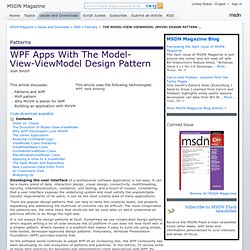
It can be a murky blend of data, interaction design, visual design, connectivity, multithreading, security, internationalization, validation, unit testing, and a touch of voodoo. Considering that a user interface exposes the underlying system and must satisfy the unpredictable stylistic requirements of its users, it can be the most volatile area of many applications. There are popular design patterns that can help to tame this unwieldy beast, but properly separating and addressing the multitude of concerns can be difficult. It is not always the design patterns at fault. As the software world continues to adopt WPF at an increasing rate, the WPF community has been developing its own ecosystem of patterns and practices. Order vs. It is unnecessary and counterproductive to use design patterns in a simple "Hello, World! " Presentation Model. Represent the state and behavior of the presentation independently of the GUI controls used in the interface Also Known As: Application Model GUIs consist of widgets that contain the state of the GUI screen.
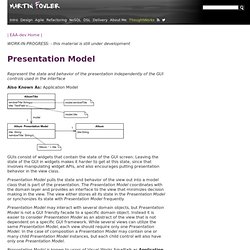
Leaving the state of the GUI in widgets makes it harder to get at this state, since that involves manipulating widget APIs, and also encourages putting presentation behavior in the view class. Presentation Model pulls the state and behavior of the view out into a model class that is part of the presentation. The Presentation Model coordinates with the domain layer and provides an interface to the view that minimizes decision making in the view. Presentation Model may interact with several domain objects, but Presentation Model is not a GUI friendly facade to a specific domain object. Model-View-ViewModel (MVVM) Explained. The purpose of this post is to provide an introduction to the Model-View-ViewModel (MVVM) pattern.

While I've participated in lots of discussions online about MVVM, it occurred to me that beginners who are learning the pattern have very little to go on and a lot of conflicting resources to wade through in order to try to implement it in their own code. I am not trying to introduce dogma but wanted to pull together key concepts in a single post to make it easy and straightforward to understand the value of the pattern and how it can be implemented. MVVM is really far simpler than people make it out to be.
Dependency Properties Overview. In WPF, properties are typically exposed as common language runtime (CLR) properties.
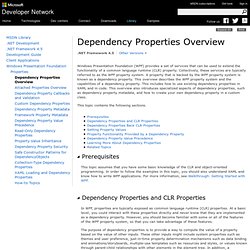
At a basic level, you could interact with these properties directly and never know that they are implemented as a dependency property. However, you should become familiar with some or all of the features of the WPF property system, so that you can take advantage of these features. The purpose of dependency properties is to provide a way to compute the value of a property based on the value of other inputs.
These other inputs might include system properties such as themes and user preference, just-in-time property determination mechanisms such as data binding and animations/storyboards, multiple-use templates such as resources and styles, or values known through parent-child relationships with other elements in the element tree. Following is a summation of the terminology that is used in this software development kit (SDK) documentation when discussing dependency properties:
Design Patterns: Model View Presenter. Data and WPF: Customize Data Display with Data Binding and WPF. Data and WPF Customize Data Display with Data Binding and WPF Josh Smith When the Windows® Presentation Foundation (WPF) first appeared on the .NET radar, most of the articles and demo applications touted its superb rendering engine and 3D capabilities.
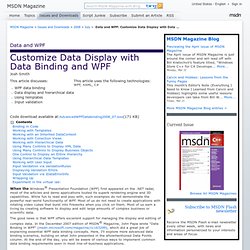
Data Binding (WPF) WPF avancé : Comprendre les événements et les commandes routés dans WPF. WPF avancé Comprendre les événements et les commandes routés dans WPF Brian Noyes Le plus décourageant, lorsque l'on souhaite se mettre à niveau dans l'utilisation de Windows® Presentation Foundation (WPF), est le grand nombre de nouvelles constructions qu'il faut apprendre à maîtriser.
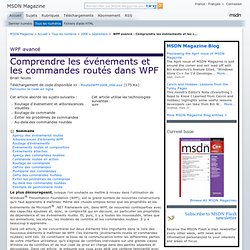
Même des choses simples telles que les propriétés et les événements de Microsoft® .NET Framework ont, dans WPF, de nouvelles contreparties avec des capacités ajoutées et, donc, la complexité qui en découle, en particulier les propriétés de dépendance et les événements routés. Et, puis, il y a toutes les nouveautés, telles que les animations, les styles, les modèles de contrôle et les commandes routées. Dans cet article, je me concentrerai sur deux éléments très importants dans la liste des nouveaux éléments à maîtriser de WPF. Data Points: Data Binding in WPF. Advanced Basics: The ObservableCollection Class. Advanced Basics The ObservableCollection Class Ken Getz Imagine that you're creating a Windows Forms application, and you have bound a DataGridView control to a standard List(Of Customer) data structure.
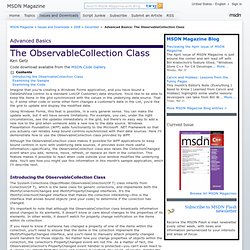
You'd like to be able to keep the items in the grid synchronized with the values in the underlying data source. Cutting Edge: Collections and Data Binding. Cutting Edge Collections and Data Binding Dino Esposito Code download available at:CuttingEdge0505.exe(159 KB) When it's time to design the Data Access Layer (DAL) of your distributed Microsoft® .NET Framework-based app, one of the key decisions you'll make is how you'll pass data to and from methods of DAL classes. There are quite a few options for passing business data to and from DAL classes, but in most real-world cases the choices boil down to just two—using DataSet objects or collections of custom business entity objects.
DataSets have built-in support for optimistic concurrency and the ability to define and handle complex relationships between tables. Données et WPF : Personnalisez l'affichage des données avec la liaison de données et WPF. Données et WPF Personnalisez l'affichage des données avec la liaison de données et WPF Josh Smith Lorsque Windows® Presentation Foundation (WPF) est apparu pour la première fois sur le radar .NET, la plupart des articles et des applications de démonstration faisaient l'éloge de son moteur de rendu et de ses superbes capacités 3D. Charting with DataTemplates. For WPF programmers, one major revelation about the power of the DataTemplate comes with a demonstration of how a little piece of XAML (Figure 1) can turn business objects into bar charts (Figure 2). Following the exhilaration at seeing the chart's rendering, the technique unfortunately seems to "stall out.
" Enhancing the simple bar chart becomes awkward, and using data templates for other types of common charts -- such as pie charts and line charts -- seems nearly impossible. That's too bad, because using data templates in this way is simply too powerful a technique to be relegated to unadorned bar charts. In this article, I will show you a few techniques to get around the apparent limitations. There will be some code involved to help out with the details that XAML can't manage by itself, but the code will often be generalized enough to use for other applications. Of course, the DataTemplate isn't a universal solution for charting. Basic Concepts. Prism (Composite Application Guidance for WPF) Patterns & practices Developer Center June 2008 Prism (Composite Application Guidance for WPF) is designed to help you more easily build enterprise-level Windows Presentation Foundation (WPF) client applications. This guidance will help you design and build flexible composite WPF client applications-composite applications use loosely coupled, independently evolvable pieces that work together in the overall application.
Composite Application Library. The Composite Application Library helps architects and developers create composite Windows Presentation Foundation (WPF) applications. Composite WPF applications are composed of discrete, functionally complete, pieces that work together to create a single, integrated user interface. Prism : Modèles pour la création d'applications composites avec WPF. Prism. Wpf - Good examples of MVVM Template. A Simple MVVM Example « Rachel Lim's Blog. In my opinion, if you are using WPF or Silverlight you should be using the MVVM design pattern. It is perfectly suited to the technology and allows you to keep your code clean and easy to maintain.
The problem is, there are a lot of online resources for MVVM, each with their own way of implementing the design pattern and it can be overwhelming. I would like to present MVVM in the simplest way possible using just the basics. So lets start at the beginning. MVVM is short for Model-View-ViewModel. Models are simple class objects that hold data. Views are the UI used to display data. ViewModels are where the magic happens.